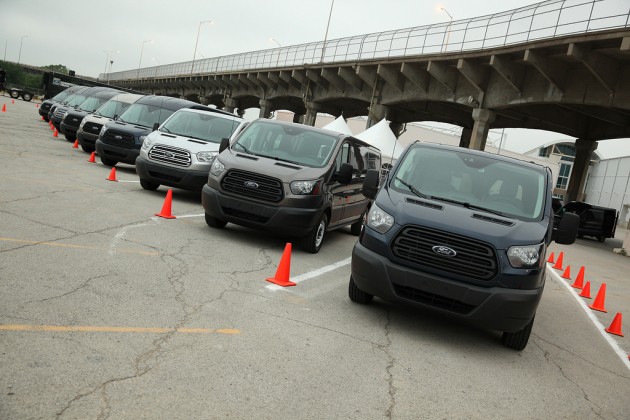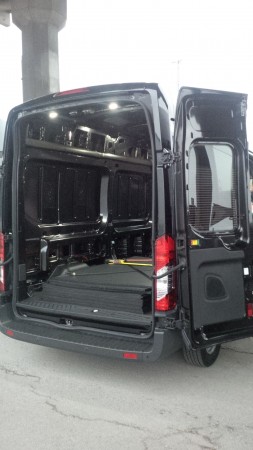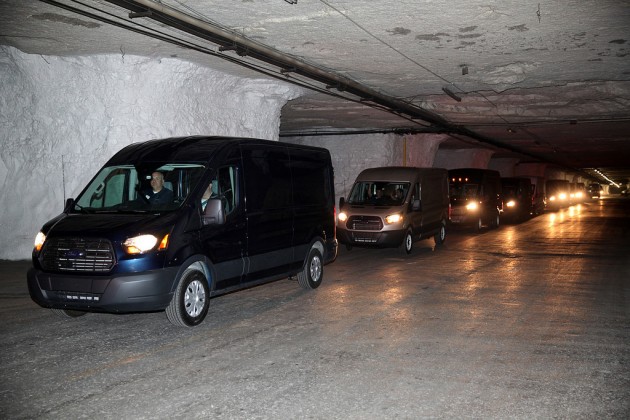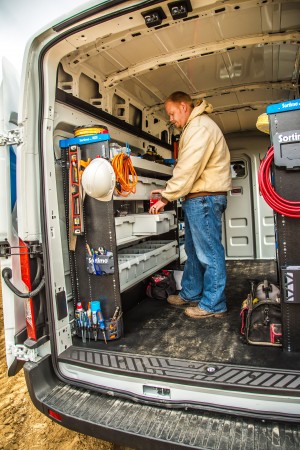The new Ford Transit cargo van
KANSAS CITY, Mo. — Ford has brought its Transit model to North America, consolidating its global cargo van platform and effectively modernizing the work van. It also has created a worthy rival to the Mercedes-Benz Sprinter, with an interior that’s comfortable, well appointed and when ordered to be so, downright luxurious.
And whoever said work vans shouldn’t be nice to drive?
The Ford Transit will replace the E-Series, which has served Ford well during its run over the past half century or so. The E-Series has been the best-selling van in the US for 35 years. But on the other side of the pond, in the United Kingdom, it was the Transit that dominated the van market. The Ford Transit is already sold in 118 markets across six continents. Some seven million units have been sold.
“The all-new Transit is one Ford, at its best,” said Kumar Galhotra, vice-president of engineering, when unveiling the new van to the media.

Like all global commercial vehicle manufacturers, Ford is looking to consolidate its vehicle platform, to take advantage of greater economies of scale and to lower production costs while enhancing product quality. The Transit will be built in three plants around the world, including in Kansas City, where Ford has injected $1.1 billion into its facility.
While the Transit will now be a truly global vehicle – with what is likely to be a major presence in the US and Canada – the vehicle has been North Americanized for this market.
“There are still several details that have to be unique for the market and we pay a lot of attention to those little details,” Galhotra said.
If you’d like an example of the North Americanization of the Transit, look no further than the abundant cupholders strategically located throughout the cab. But perhaps more importantly, especially to the fleet buyer, the engines have been calibrated for optimum efficiency over North American roads and duty cycles.
A versatile van
The new Ford Transit is as versatile a vehicle as you will find. It can be ordered with three roof heights (high roof, 110.1”; medium roof, 100.8”; and low roof, 83.6”) and in two wheelbases (129.9” and 147.6”). It can be had as a van, wagon, chassis cab or cutaway.
Three engine options are available: the standard 3.7L V6 (275 hp/260 lb.-ft); the 3.5L EcoBoost 310 hp/400 lb.-ft.); and the 3.2L Power Stroke diesel (185 hp/350 lb.-ft).
Jim Mazuchowski, manager of V6 engine programs for Ford, said the 3.5L EcoBoost, lifted straight from the Ford F-150 where it’s the most popular engine available, provides 46% better fuel economy than the E-Series with the 6.8L V10.
“It has a very nice, broad torque curve, so you get that torque and keep that torque, which is particularly good for towing,” Mazuchowski said.
And the Transit can tow. Its towing capacity is 7,500 lbs and its maximum payload is 4,650 lbs, with up to 487.3 cubic feet of cargo space available. Compared to comparable E-Series vans, the Transit boasts an extra 600 lbs of payload.
On the road

I drove several Transit cargo vans during a trip to Kansas City, sampling all three available engines (see spec’s below). Each was loaded up with about 2,000 lbs of cargo in the back – well below its capacity but a fairly typical payload for this segment. The weight was a non-issue. Weather was an issue for the morning portion of the drive, with heavy rains and thunderstorms. Nonetheless, visibility through the massive windshield was excellent; the defogger keeping the oversized glass clear and the wipers keeping up with the driving rain.
The Transit is available with rain-sensing wipers, an option that would previously seem unthinkable in a work van. It speaks to the high attention to detail that went into the design of the driver environment.
All three vans drove nicely. The interior was quiet, aside from the rain driving down on the metal roof. Power and torque were abundant on all three vehicles. If anything, the 3.5L EcoBoost was probably overpowered for the application, but if you like power, you’ve got it.

The Ford Power Stroke I5 diesel was impressively quiet. All Transits come standard with a six-speed SelectShift automatic transmission.
The interior is well designed with lots of power options for cell phones and other electronics as well as cleverly located storage spaces. Drivers stepping out of an old-school work van are going to have a hard time finding anything to complain about when upgrading to the Transit.
Fleet owners will be comforted to know the visibility is excellent, making the Transit an ideal vehicle for urban deliveries, even when in the hands of drivers of limited experience.
Cargo accessibility is also sure to be appreciated. The rear doors swing open a full 270-degrees, providing easy access to goods. A wide rear step allows easy entry into the back of the van and a step is even offered on the front bumper to make cleaning the large windshield easier.
Upfitting and tracking
To prevent upfitters from having to make their own holes, Ford has built up to 10 mounting points directly into the roof. This simplifies the installation of ladder racks and other equipment and reduces the risk of rust forming where holes have been drilled, penetrating the paint and primer.

Upfitters seem excited about the possibilities. We drove to Subtropolis, a massive 5 million sq.-ft. underground industrial park where limestone was once – and continues to be, well below – extracted. Several upfitters are located there. They like the constant temperatures (70 F, 365 days a year) and the tax advantages of being located underground.
Knapheide welcomed us to its underground shop and showed off the new KUV (Knapheide Utility Vehicle) built upon a Ford Transit chassis. The company also introduced a new Sortimo interior storage system that allows contractors to better organize tools and supplies within the van.
Fleet managers can choose the Crew Chief telematics platform, powered by Telogis, to keep track of their vehicles. It does everything you’d expect of a telematics system, notifying fleet owners of naughty drivers who are prone to speeding, hard braking, etc. It even works on naughty journalists, as we found out when it was pointed out to us that one of the Transits on the test drive achieved 70 mph in a 40 zone. Crew Chief appears to be very easy to manage, with colour-coded graphs and charts that score drivers on their behaviour and easily identify those who require some constructive criticism.
Crew Chief is available in Canada and costs about $800 to install and between $30-$40 per month after the first year, depending on the service level required. (Monitoring is provided free of charge for the first year).
Overall impressions
I like the Ford Transit, quite a lot. It’s a smart, well-configured vehicle that has a place in today’s goods-moving industry. Commercial drivers are hard to find and those who want to deliver into major cities, even more so. And big cities such as Montreal and Toronto aren’t becoming any more truck-friendly. The European model of delivering freight – breaking down shipments outside the city and delivering them to their final destinations inside smaller, more efficient vehicles – is attainable here. It sure beats maneuvering a 53-ft. trailer downtown and picking up parking tickets all day long.
And the Transit is efficient. Its EPA fuel economy ratings for both the 3.5L EcoBoost and 3.7L V6 are 14 mpg (16.8 L/100 km) in the city and 19 mpg (12.38L/100 kms) on-highway. That makes the EcoBoost 46% more fuel-efficient than the E-Series with the 6.8L V10 and the standard 3.7L up to 19% more efficient than the E-Series’ standard 4.6L V8.
Combine all this with Ford’s extensive dealer footprint and convenient serviceability and a reasonable price point, and it’s hard to imagine the Transit not succeeding. The Transit’s modern, European-inspired design makes the boxy work vans of yesteryear look archaic. And its versatility, efficiency and drivability ensure it’ll be equally popular among drivers and fleet operators.
2015 Ford Transit 250 Medium Roof Van
- Wheelbase: 148”
- Engine: 3.5L EcoBoost V6
- Transmission: Six-speed SelectShift Automatic
- Other features: 6.5×16 steel wheels (black); fixed rear door glass; leather 10-way power driver seat; trailer tow package; cruise control; rearview camera; reverse park aid; trailer brake controller; six speaker package; cargo area load area protection package; power inverter; privacy glass.
- MSRP as spec’d: US$38,685
2015 Ford Transit 350 High Roof DRW Van
- Wheelbase: 148”
- Engine: 3.2L I5 diesel
- Transmission: Six-speed SelectShift Automatic
- Other features: Fixed rear door glass; pewter cloth 10-way power driver seat; engine block heater; reverse park aid; trailer tow package; trailer brake controller; interior upgrade package (AM/FM stereo/single CD/Sync; cruise control; dual illuminated visors); mirrors, long power; white DRW package; rear window defogger; rearview camera; Securilock pats; six speakers; cargo area load area protection package; privacy glass.
- MSRP as spec’d: US$50,185
2015 Ford Transit 250 Medium Roof Van
- Wheelbase: 148”
- Engine: 3.7L Ti-VCT V6 (Standard)
- Transmission: Six-speed SelectShift Automatic
- Other features: Fixed rear door glass; pewter cloth 10-way power driver seat; reverse park aid; rear window defogger; rearview camera; heavy-duty alternator; interior upgrade package (AM/FM stereo/single CD/Sync; cruise control; dual illuminated visors); six speakers; Securilock pats; runningboard – passenger door; cargo area load area protection package; privacy glass.
- MSRP as spec’d: US$37,970
Have your say
This is a moderated forum. Comments will no longer be published unless they are accompanied by a first and last name and a verifiable email address. (Today's Trucking will not publish or share the email address.) Profane language and content deemed to be libelous, racist, or threatening in nature will not be published under any circumstances.











Hi James,
have you any news on the functionality of the 2016 ford transit diesel medium roof and medium wheel base. My van brakes down all the time.
thank you,
Sylvio